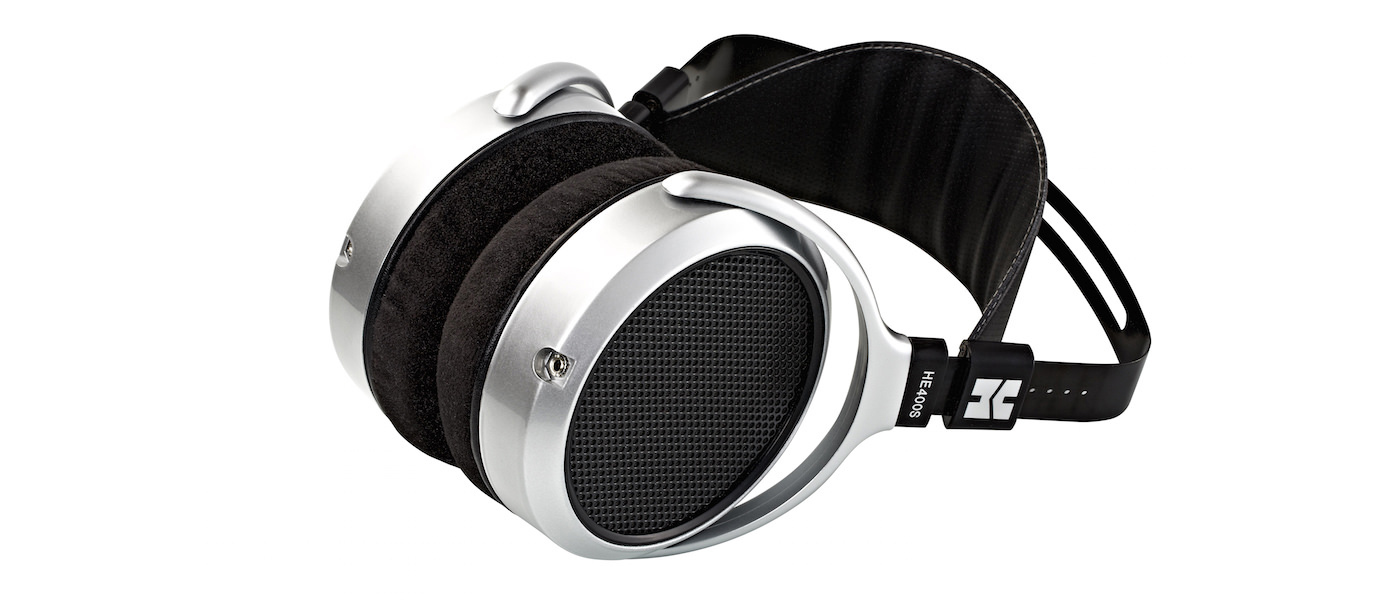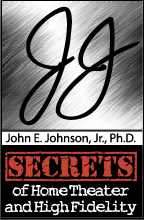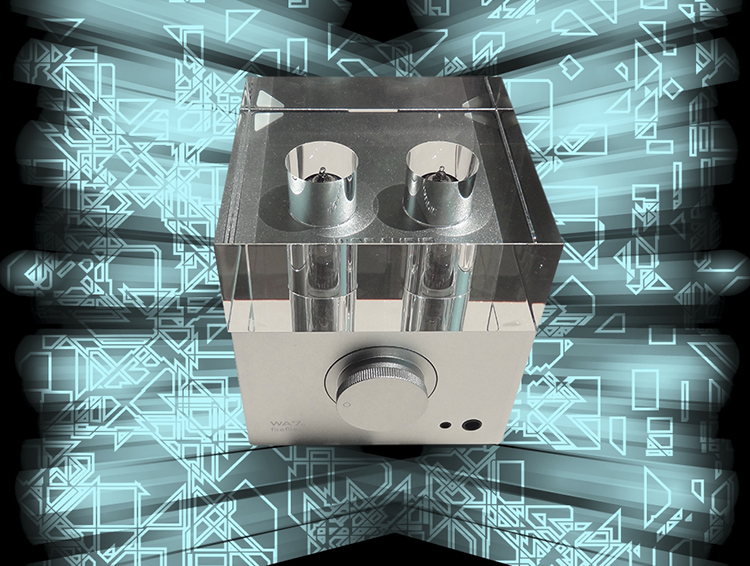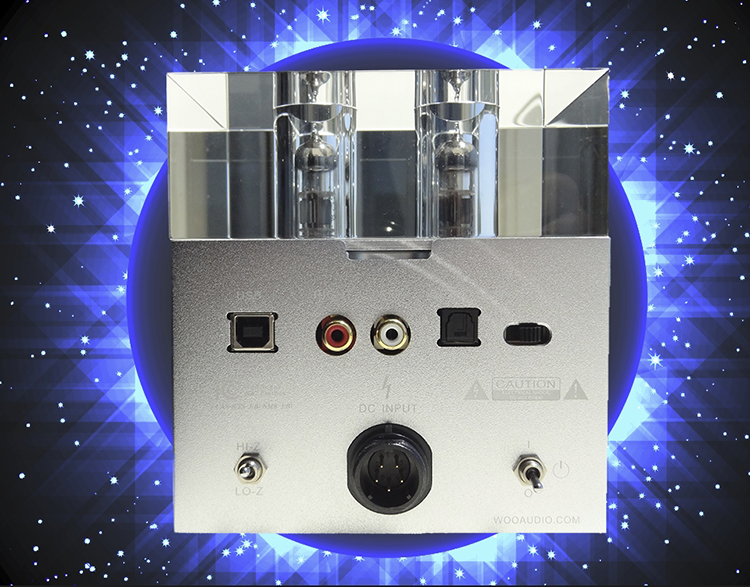It seems every company that makes amplifiers has or will have a headphone amplifier in their product lineup.
Woo Audio makes a number of models, and in this review, we examine the WA7d, which uses as single tube for the single gain stage of each channel.
I was amazed at the satin-smooth sound, but not surprised. The amp runs in Pure Class A, and the distortion spectrum (see On the Bench) looks just like one would expect, with high second and third ordered harmonics, but virtually no higher ordered harmonics. That gives you the lush mids that tubes are so famous for.
You can buy the amplifier with a solid state power supply (standard) or with a tubed power supply. The review unit came with the solid state power supply. At $1,199, the WA7d is a bargain.
Woo Audio WA7d Fireflies Headphone Amplifier and DAC
- Great sound
- Single-ended Pure Class A operation
- Has that lush tube sound character
- Will drive any headphones
- Optional tube power supply
Headphones and headphone amplifiers are a hot ticket these days. It’s all part of the retro movement, including tubes, turntables and vinyl. I listened to headphones almost exclusively in the 1960’s.
Headphones and their amplifiers have always been around, but everything changed a few years ago when headphones became available with planar magnetic drivers. These drivers give the listener an experience that competes with, and often surpasses, the sound of a good set of speakers.
Design:
Tubed Headphone Amplifier with DAC
Tube:
Two 6C45 Nine-pin Triodes
Power:
Pure Class A; 6 Volts Max Output
THD+N:
0.03%
DAC: TI PCM5102A 32-bit
DESCRIPTION
C-Media 6631A
USB Chip
Sampling Rate:
Up to 32/192 PCM
MFR:
11 Hz – 27 kHz, ± 0.5 dB
Headphones impedance:
8-600 Ohms
Input impedance:
100 kOhms
Inputs:
One Optical (TOSLINK), One Asynchronous USB 2.0, One Pair Analog RCA
Outputs:
One 1/4″ and One 1/8″ Headphone
Dimensions:
Amplifier: 5.1″ H x 4.8″ W x 4.8″ D with Glass; PSU: 2.2″ H x 3.5″ W x 7″ D
Weight:
Amp with Glass – 6 pounds; PSU – 2.8 Pounds
MSRP:
$1,199 USD; Optional Tubed Power Supply WA7tp – $649 USD
Company:
SECRETS Tags:
Woo Audio, Headphone Amplifiers, Class A, Tubes
So, the whole ballgame has changed. Headphones and amps are all over the place. Amplifier manufacturers all have, or will have, headphone amps included in their line. Some also make headphones, but the headphone market is a category by itself, with manufacturers going full steam to keep ahead of their competitors. New models arrive monthly, and there is no end in sight.
Secrets Sponsor
Good stuff is not cheap, and that includes headphones and headphone amplifiers. Although the Woo Audio WA7d headphone amplifier is only $1,199, there are amps out their that cost several thousand, and I mean like $5,000 and up. The latest headphone addition is $3,000. So, you could be listening to a setup that sits on your end-table that cost you 10 large.
The WA7d is a stereo tubed headphone amplifier with a DAC included. The DAC is capable of processing up to 32/192 PCM. The power supply is solid state.
The rear panel is shown below. It has inputs for USB (from your computer), Toslink optical digital, and RCA analog. There is also a multi-pin jack for connecting the power supply to the main chassis.
Two 6C45 triodes are used for the single gain stage, which is biased into Pure Class A.
Here is the pin-out for the tube. You can see that the cathode is indirectly heated, which reduces the likelihood of hum (compared to directly heated cathodes). There are nine pins, with four of them going to the cathode heater. This allows switching in higher or lower voltage to heat the cathode, which makes the tube performance parameters very flexibile. The 6C45 is a relatively new tube, and very cleverly designed (photo from The Tube Store.)

The main chassis also has a selector switch for low impedance headphones (<200 ohms) and high impedance headphones (> 200 ohms). However, some low impedance phones sound better when the high impedance switch is activated, and vice versa, so you should just try it out and use the one you like. I used the high impedance switch.
The WA7d delivered a maximum of 6.5 volts into 39 ohms.
I tested the WA7d with a pair of HiFiMAN HE-560 headphones and OPPO PM-1 headphones. I used the USB input and JRiver music player in a Windows 8 laptop computer.
Here is the setup on my end-table next to my favorite chair.

Vivaldi’s Four Seasons is a masterpiece of the Baroque era, and is one of the most popular classical compositions ever written. I played several versions, and noticed immediately that the violins had a distinct “presence” that was incredibly smooth. This is characteristic of an amplifier that has a Pure Class A single-ended triode design. It is hard to put into words, in fact, and “presence” doesn’t do it proper justice. Even if you are not at all into tubes, you would like the way this configuration sounds with high frequency instruments.
Secrets Sponsor
Going to my amp-buster track, Copland’s Fanfare for the Common Man, I found the bass not to be as loud, compared to the mids and highs, as I would like it, but again, tubes have this quality, as they often are a bit less intense in the bass than solid state amplifiers. Modern tube amplifiers don’t have tone controls, so you can’t turn up the bass, but nevertheless, it was enough bass to satisfy. I just noticed it as compared to one of my reference headphone amplifiers, the OPPO HA-1, which is a balanced Pure Class A solid state product.
Beethoven’s Symphony No. 9 is my favorite of the nine symphonies he composed. The last movement, in particular, has a melody that everyone would recognize. It sounded truly beautiful on the Woo WA7d. In particular, the basso profundo (person singing the bass line), sounded like he was standing next to me. And, when the full symphony was playing, the whole spectrum was crystal clear, with each instrument detectable. That is a tribute to both the amplifier and the headphones, which use a thin film as the driver (planar-magnetic).
Buddy Rich’s “Away We Go”, from his The New One album, an analog recording of decades ago and transcribed to digital, is a track to behold. The WA7d allowed his ride cymbal to be heard very clearly (Rich didn’t like to have microphones attached to each drum and cymbal, so the recording had to be made with the microphones a few feet away). Both the tenor sax and trumpet solos came through brilliantly.

I listened to a new (new to my collection, first released in 1987) CD: William Boyce: 8 Symphonies, (Archiv 419631-2) which is Baroque classical. The violins and trumpets did their thing, and I was transfixed with the detail and musicality.
The glass top of the WA7d became rather hot during use. This is because the amp is biased into Class A. I am not sure about the heat transfer from the tubes to the walls of the cylindrical opening in the glass where the tubes sit. If it were my design, I would drill a few holes coming in from the side at an upward angle to allow the cylinders to act as chimneys for cool air being drawn in from the holes. But, it’s not my design, and the holes would certainly take away from the appearance of the glass.
The spectrum shown below sums up how a single-ended triode biased in Pure Class A performs (1 kHz, 16/44.1 test signal). At 1 volt output, distortion is just below 1%, which seems like a lot, but only in comparison to a solid state amplifier. Notice that the distortion is virtually all second- and third-ordered harmonics, with the fourth and fifth harmonics below -100 dB and inaudible. Second- and third- ordered harmonics are euphonic, and are responsible for the “presence” that I heard in the recordings. Even some very expensive tube amplifiers have a lot of this type of distortion (some as high as 3%), but the sound is still great because of the audible nature of these low-ordered harmonics.

Woo Audio Scores a Top Tier Performance/Price Ratio with the WA7d Fireflies Headphone Amplifier and DAC.
- Great tube sound
- Single-ended biased into Pure Class A
- Glass top shows off the tubes
- Excellent performance/price ratio
- More heat dissipation
- Power switch on the front
- Dark lettering (white letters on silver background are hard to read)
The Woo Audio WA7d is a bargain at $1,199, and you can add to that with the tube power supply (WA7tp – $649), but the solid state power supply is very good as well, so you won’t be missing much, if anything, by just having the setup with the solid state power supply. You can always add the tube power supply later if you wish.
I spent a number of afternoons listening to music at varying sampling rates, including 24/192, through this system, and I am sorry to see it go. If you are looking for a great little headphone amplifier, that looks beautiful with its glass top, the WA7d should be on your short list.
I look forward to reviewing more of Woo Audio’s headphone amps. It’s an irresistible pleasure.





